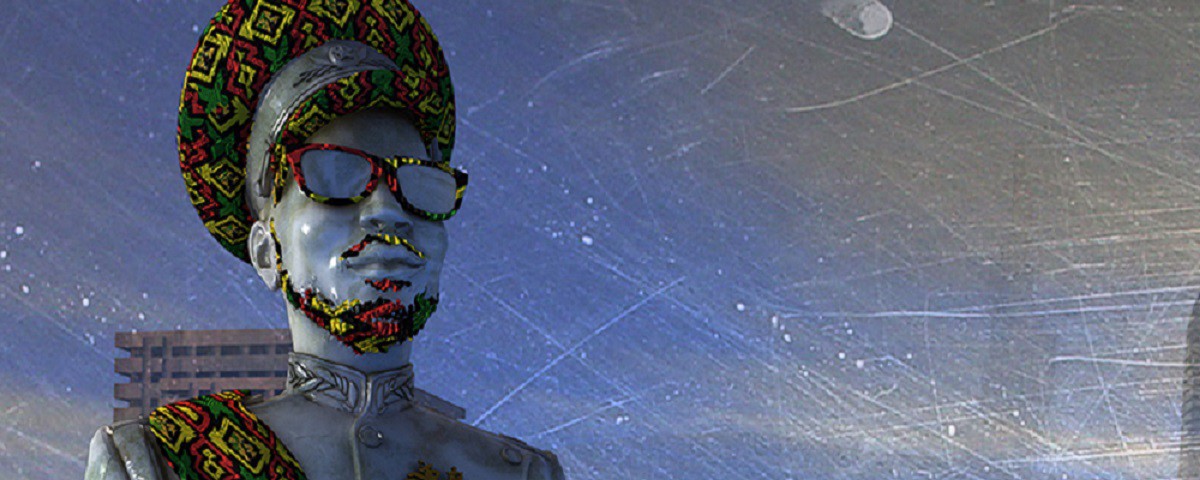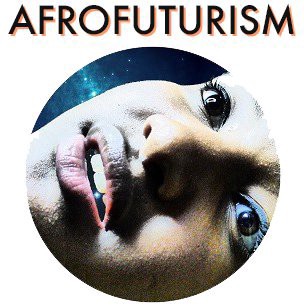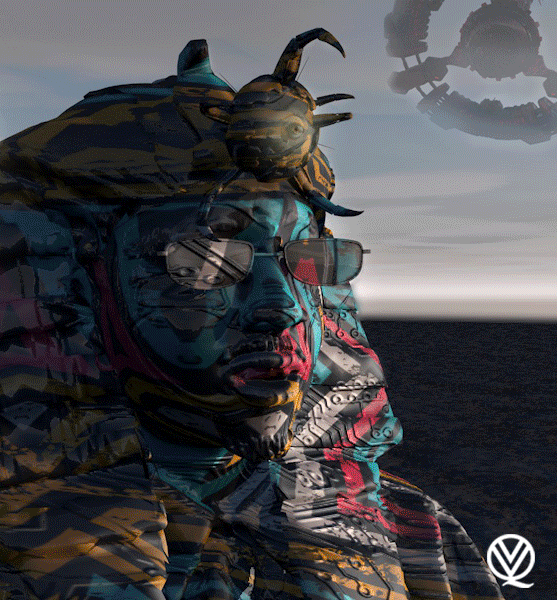

Editor’s note: Florence Okoye is the founder of AfroFutures_UK, a British-based collective of artists, hackers, activists, and academics looking at how Afrofuturism envisions the future. She is our guest curator for this part of our site, and we’re thrilled to have her aboard.

Why are there so few black sci-fi writers? For critic Mark Dery, who coined the term “Afrofuturism” in 1993, this was the most important question. He wrote:
“African-Americans, in a very real sense, are the descendants of alien abductees; they inhabit a sci-fi nightmare in which unseen but no less impassable force fields of intolerance frustrate their movements; official histories undo what has been done; and technology is all too often brought to bear on black bodies”¦
Can a community whose past has been rubbed out, and whose energies have subsequently been consumed by the search for legible traces of its history, imagine possible futures? Furthermore, isn’t the unreal estate of the future already owned by the technocrats, futurologists, streamliners, and set designers–white to a man–who have engineered our collective fantasies?”
Dery answered his own question by defining Afrofuturism as “speculative fiction that treats African-American themes and addresses African-American concerns in the context of twentieth-century technoculture.” In doing so, he recognized writers like Octavia Butler and Samuel Delany, who threaded critical black and queer perspectives throughout their works. Going back to the early 20th century, he noted also how writers like Ralph Ellison and W.E. DuBois used speculative fiction to rethink the way a black person could create a new identity, empowered by the technology of their time.
It’s also important to note that although Dery originated the term “‘afrofuturist’, he was preceded by scholars such as Mark Sinker and Greg Tate, all of whom wrote about the “‘interface between science fiction and Black Music‘. In many ways, his initial question betrayed an ignorance not just of black science fiction but also of how literary conventions–the disregard of science fiction, the segregation of black and non-Western literature–are influenced by and in turn impact the representation of non-white voices.
But Afrofuturism goes beyond literary genre fiction. We might not realize it, but many of us brought up with late 90s hip-hop and R&B were surrounded by sci-fi imagery. Who remembers the music video for “What’s It Gonna Be?,” the Busta Rhymes track featuring the genius Janet Jackson? Or TLC’s “Unpretty,” in which the singers use flying cameras like some futuristic, three-faced goddesses in a cybernetic Elysium to look into the secret lives of those traumatized by body image and social expectations? Or how about any of Missy Elliott’s music videos?
They’re all part of an Afrofuturist heritage in black music that runs from Sun Ra and George Clinton through to Jimi Hendrix. As Kodwo Eshun says in his book More Brilliant Than the Sun, if you want to see Afrofuturism in its purest form, look not to literature but to “sonic fiction”–the genres of hip-hop and grime. What other music encapsulates techno-post-modernity more truly than rap lyrics dancing over sampled loops, remixed tracks, and ripped beats? Even the way in which “urban” or “black” music (as it is generally called) gets produced has a tech-savvy disregard for conventionality–the kind of chutzpah you’d expect from cyborgian alchemist characters in an unwritten William Gibson novel, working on mind-altering audio-substances in a chemistry lab to intoxicate the disenfranchised masses.
This, for me, is what Afrofuturism is all about. It is the realization of the infamous statement by artist Alisha B. Wormsley, who said: “There are black people in the future“; it is, as Kodwo Eshun writes, “a program for recovering the histories of counter-futures created in a century hostile to Afro-diasporic projection.” It is an answer to the existentialist conundrum of the afro-geek.
After all, to quote musician Gabriel Teodros: “If we don’t write ourselves into the future, we get written out of tomorrow as well.” Unlike in mainstream science fiction–where black people are mysteriously absent, or doomed to be the first victim of an extraterrestrial threat (it’s not just in horror flicks that the brother dies first)–Afrofuturism dares to suggest that not only will black people exist in the future, but that we will be makers and shapers of it, too.

My own journey into Afrofuturism emerged from several places, but two in particular come to mind: first, from an interest in science and technology–something that seemed fairly radical for a black girl–and second, from the #RaceFail of 2009, a wide-ranging debate about race in science-fiction fandom across social media, which I experienced on the outskirts as a lowly denizen of LiveJournal. What I gained from the latter was a glorious sense of purpose; there it became clearer that there was so much that black culture could contribute to genre fiction. This was where I learned the vocabulary to critically examine genre fiction, while also finding the impetus to want to change it.

The reappropriation of African cultures and spirituality–whether Kemetic, Bantu, Dogon, or other–might seem superficial but is actually an important part of the journey to rehabilitate blackness with progress. Not only can we as black people create our futures from this point in time, but we have always had that ability. Far from abandoning our pre-colonial roots as “uncivilized,” we can reach back to our past to inspire our futures.
Through multimedia remixes of historical imagery, genre conventions, and contemporary sociological theory, Afrofuturism encourages black people–both in Africa or among the black diaspora–to grapple with their understandings of technology and its impact on our cultures and social experiences. For much of the last three centuries, the dominant perspectives on history were white and European, which castigated cultures from the “Dark Continent” as backwards, pre-Enlightenment, and incapable of incubating technology and progress without the help of their charitable colonizers. Afrofuturism is our counter.
However, beyond just being a way to talk about our past, Afrofuturism also allows us to reimagine what technology can be used for. It can be an act of healing–necessary for a racial group whose unwilling bodies were used for medical experiments and preyed upon in other ways. Although the global black community has often received the dregs of progress, Afrofuturism is a vital way of reimagining how we can reclaim those technologies that came from our exploitation.
In fact, in many ways we’ve moved beyond reimagining to actually creating–take a look at social movements like #BlackLivesMatter and you see a network of globally connected activists using social technologies, such as Twitter, Tumblr, and Facebook, to carry out radical activism and fight oppression. When I hear cultural critics like Caitlin Moran speak about the dangers of Twitter for women, it does make me wonder whether a little intersectionality wouldn’t go amiss. For a queer black woman like myself, these technologies have provided both an education and liberation–in some ways more so than they’ve been a place of abuse and oppression.
Indeed, one of the best things about the movement is being able to dream of a truly intersectional future between any number of social identities. For instance, Afrofuturists like Rasheedah Philips use it as a way to better serve their communities as activists while also taking cliched plotlines like time-travel paradoxes to explore alternative futures; meanwhile, artists like Tabita Rezaire use cyber media to tear apart notions of gender and racial disparity. Afrofuturism is not just a genre–it’s a way to reframe science, history, technology, and religion, as well as race and society.
Seeing how this intersectional approach has fed social justice movements committed to showing that the future has to be worth living in for everyone, I’m reminded of themes in Octavia Butler’s short story “Bloodchild,” which features refugee humans and their bug-like alien hosts living together peacefully, but only when both sides consider the other’s needs. They make free decisions outside of an oppressive system–an attitude commonly found among Afrofuturist artists, activists, and technologists alike.
Back to Earth, in many parts of Africa–where infrastructure is a major obstacle for people to access medical healthcare and education–it’s this sort of vision that’s led to the birth of community tech hubs, where local makers create technology to improve people’s lives. In some cases they’re educating and protecting vulnerable members of society from further abuse and exploitation. Others have used technology to become modern day griots, creating visual and sonic allegories (like the Kenyan film Pumzi, above) for how we can live in closer harmony with our planet’s resources.
One of the many reasons I’m excited about working with How We Get To Next this month is that it’ll offer a chance to provide a global perspective on what is happening with Afrofuturism now. Join us as we journey across continents, meeting hackers, activists, academics, filmmakers, artists, and social innovators. To quote writer Chardine Taylor-Stone, “Afrofuturism provides a lot more to the black experience than simple escapism, silver Dashikis, and pyramid-shaped spaceships.” It is the place where art, politics, race, and technology meet, transformed and fused to create new visions of what it means to be black, to be human, and to be a community in the future.
So, let’s press on with the adventure. The revolution may not be televised, but hopefully by the end of this season, you’ll have learned enough to know it when it comes.


How We Get To Next was a magazine that explored the future of science, technology, and culture from 2014 to 2019. This article is part of our collection of conversations about Afrofuturism, curated and edited by Florence Okoye of Afrofutures UK. Click the logo to read more.
